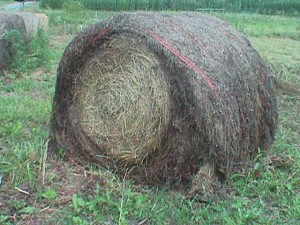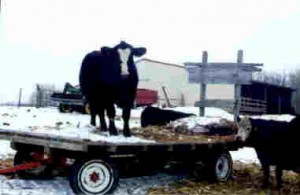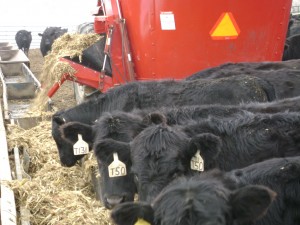– Stan Smith, Program Assistant, OSU Extension, Fairfield County (reprinted from the Ohio Cattleman’s Association Magazine, Early Fall, 2008)
Back in ‘the day’ as a youth, I cut teeth on an Allis Chalmers Roto Baler. I never really asked why we had a round baler when no one else in the community did. I simply knew that when it was time to make hay, Steve and I were expected to be there.
Grandpa, dad and my uncle had created a pull type, ground driven bale elevator that conveyed the bales, which had been dropped to the ground after they were rolled and tied, onto hay wagons for transport to the barn. The first task we learned as boys was how to drive this bale elevator in a fashion that got the bales onto the wagon efficiently and without needing to jump off the tractor and straighten up a bale for the elevator. After all, these bales weighed 50 pounds a piece, and at the age of 8, we were happy to earn a nickel an hour driving the tractor instead of wrestling those 50 pound ‘rolling pins’ across the wagon or the hay mow. I often wonder today if it wasn’t Allis Chalmers decision in 1960 to discontinue manufacturing the Roto Baler that became the precursor for shortly after seeing weight rooms being established in high school athletic facilities. But, that’s a conversation for another time.
Regardless, after all that being said, the real point I’m trying to make is that these round bales were picked up from the field as soon as possible after being baled, and then transported to barns for storage until they were fed. I wonder what they knew then, that we don’t know now.
As the AC Roto Baler became less popular, it was quickly replaced by larger round balers, and the need for storing hay inside seemingly disappeared. Today, large round bales of hay appear across many rural landscapes, unfortunately deteriorating a little bit more each day that they are housed outside. In fact, data collected by several Midwest Universities suggest that we are quite likely losing 20% of our baled nutrients from hay which is stored outside until it’s fed in mid or late winter.
When hay was worth $40 a ton, and any feeder calf with 4 legs and 2 good lungs was bringing $625 a head, perhaps it wasn’t a big deal. Today, the value of hay and other feedstuffs dictates the “winds of change” may have simply returned us to a place that Grandpa likely knew we should have never left. That is simply, “crops” were meant to be stored under roof!
As Hank Kimball may have told Oliver on Green Acres a time or two, “I’m here from the Government and I’m here to help.” The new Farm Bill has a provision in it which will now allow hay growers to acquire low interest loans in order to build hay storage barns. These loans may be for 12 years, and the interest rate in July, 2008 for grain bin loans, after which the hay barn program is patterned, was 3.375%. Quite a good deal, yet, one may still ask, “Can I afford to build a barn just to store hay in?” Grandpa would have responded by asking why on earth you’d even consider storing feed outside?
As was frequently suggested during and since the OSU Extension “New Realities” series of beef cattle production meetings which were conducted last winter, the economics of this industry have dramatically changed, perhaps forever. When hay was valued at only $30 to $40 a ton, and it was abundantly available most anywhere, some might have argued they simply couldn’t afford to dedicate a building to hay storage. A quick look at the numbers today suggests it may be false economics to even consider utilizing hay as a basis for a beef cattle operation without the benefit of sheltered storage.
When hay bales sit outside and weather an average of 2 to 4 inches down into the bale, Table 1 from the University of Kentucky’s publication “Round Bale Hay Storage in Kentucky” suggests 20% of the bale volume might easily be lost. When hay is valued at $100/ton as suggested in an article written by Rory Lewandowski’s and published in the Ohio BEEF Cattle letter (June 4, 2008, Issue #590 at beef.osu.edu), it becomes a loss of $20 per each ton which weathers as described above while being stored outdoors.
If we can build a ton of sheltered hay storage capacity (approximately 20 square feet of floor space, 12.5 feet at the eaves, or 250 cubic feet) for $194 or less, the annual cost of the building amortized over 12 years at 3.375% interest will be less than the $20 per ton in value losses which may easily result from outdoor hay storage.
While we’re visiting the issue of getting as many of the hay nutrients we harvest as possible preserved until we can feed them, it may be time to evaluate how they’re fed. While we may lose 20% of our hay crop to poor storage management as indicated previously, additional losses of 12% or greater may be experienced as a result of poor bale ring management. Even worse, researchers suggest that unrolling round bales on the ground for feeding may result in as much as 40% loss. These feeding losses result from trampling, further weathering, manure contamination, and refusal resulting from mud or other issues which deter the animal from consuming the hay which is offered.
Frankly, I don’t recall ever seeing a steel “bale ring” highlighting the landscape as a youngster. It seems most everyone I recall was feeding hay in a bunk. Maybe they knew something back then that we’ve forgotten.
(above) Perhaps, a cost effective bale feeder when hay was only valued at $10 per roll??
While large round bales, even those stored in a barn, are not conducive to being fed in most bunks, once they are processed or ground up they certainly would be. Better yet, you may recall in an Ohio BEEF Cattle letter last winter (February 6, 2008, Issue #573 at beef.osu.edu) that Francis Fluharty suggested to us processed hay is 30% more digestible than long stem hay is when fed as it comes directly from a typical large round bale. As we look for ways to save on the 12% feeding losses we typically experience in bale rings, perhaps we might consider processing forages to gain an additional 30% utilization.
As we examine the reality that all feed resources have become much more valuable and will likely remain so, the traditional methods – if methods which we’ve established over only the past 40+/- years can be considered “traditional” – of handling, storing and feeding hay may be obsolete. Not only is hay a commodity which should likely be stored inside, but the manure which results from feeding it is now likely a commodity which provides valuable crop nutrients instead of burdening us as a waste product. But then, if I remember correctly, manure was our primary source of crop nutrients “back in the day” too. Perhaps, the “winds of change” have simply come full circle!




